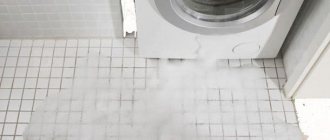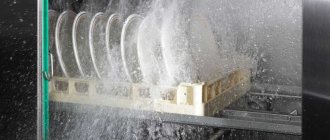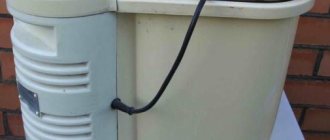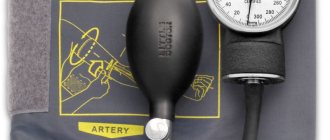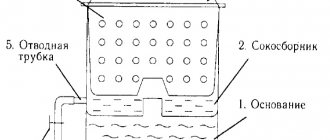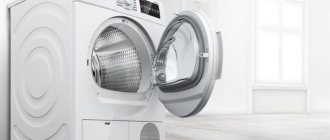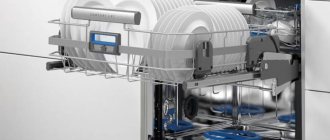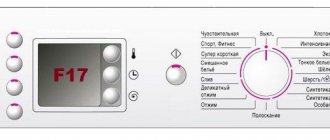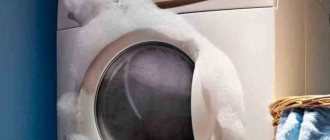The washing machine has made caring for clothes much easier. After putting dirty things in it, after a while you can take out absolutely clean ones. However, after washing, clothes also need to be dried. For this purpose, a balcony is traditionally used, on which rows of ropes are stretched, or special room dryers. But manufacturers of household appliances have long figured out how to improve the drying process by releasing special drying machines.
True, this technique is not very popular yet. Many still consider it an unnecessary luxury. Whether you need a dryer is, of course, up to you. But you will agree that the ability to dry clothes immediately after washing has many advantages. Firstly, your balcony will finally be free of decoration in the form of ropes and wet clothes, and you can calmly spend time there without fear of getting your washed clothes dirty. Secondly, you don’t have to wait several hours for your clothes to dry. Thirdly, dust from the street does not settle on it and unpleasant odors, for example, from cigarettes that my beloved husband smoked on the balcony while clothes were drying there, are not absorbed. Many models of dryers can even relieve the owner of the need to iron clothes - they can be immediately put in the closet.
A dryer is especially necessary for families with small children, where they have to wash and dry a large amount of laundry every day. Our mothers and grandmothers hung wet rompers over the stove to dry them quickly, but we can optimize this process by using a dryer. Some models can disinfect clothes with steam, which is very important for children's clothes.
The dryer can also be used for other purposes. For example, to refresh everyday clothes if there is no need to wash them. The device can clean soft toys that accumulate large amounts of dust, fluff pillows, or gently dry shoes.
How does this miracle of technology work and what should you pay attention to first when buying a dryer? You can learn about this and much more from our article.
How do dryers work?
Most dryers look similar to washing machines. They have almost the same body, control panel, hatch and drum. The hatch can be either with or without glass (completely plastic).
The dryer drum has a very large volume (from 80 liters) to dry a sufficient amount of laundry at a time. You can load up to 8-9 kg of wet clothes into them. If you have a washing machine with a load of 5-6 kg, choose a dryer with the maximum capacity to dry all the washed clothes at once. Keep in mind that wet clothes are heavier than dry ones.
The dryer does not need to spin the drum very much, so its speed rarely exceeds 100 rpm. The principle of operation of a drying machine is the same as that of a washing machine, only in it, instead of water, the laundry is treated with heated air. Evaporating moisture condenses and is removed in different ways, which we will discuss below.
Modern dryers have several programs for drying clothes. With intensive drying, it is dried in less than an hour with very hot air, but some fabrics may shrink after this. A gentle regime is intended for them, which takes much longer.
The Iron On program leaves items slightly damp, making them easier to iron. By turning on the “Into the closet” mode, you will receive completely dry clothes that can be immediately stored. Timed drying is used when clothes only need to be dried a little. When you turn on the “By fabric type” mode, the machine automatically sets the required time and temperature depending on the type of material.
How to choose a dryer
An electric dryer can be large or small, require connection to a drain or exit to the street, contain a whole range of ready-made drying programs or have only a couple of switches, not to mention a wide range of prices. Choosing drying household appliances is much easier if you pay attention to the combination of the parameters given below.
Device type
Some of the first drying machines were cabinets. This element of furniture resembles an ordinary wardrobe; it can even be decorated with panels in the color of other furniture in the room or hallway to hide it. The advantage is that the clothes hang in it as usual, on hangers. In fact, having hung shirts and dresses in such a unit, you can leave them there and store them. However, due to their large size, narrow specialization and high price, such devices are rarely found in Russia, except perhaps in some wealthy private homes.
Much more common are drum devices that resemble washing machines. In them, clothes are placed in a cylindrical container with holes, which slowly rotates and is blown with dry warm air. It is the gradual stirring of clothes that gets rid of dried folds, jammed flaps on pockets and collars bent during drying. In addition, the installation of such a machine is no different from the usual washing machine, only even simpler, since there is no need to supply water.
What types of dryers are there?
Drying circuit
The physical essence of drying wet clothes after washing in different machines is the same. Under the influence of a stream of hot air, the water with which the fabric is saturated passes from a liquid state to a gaseous state. That is, at the entrance there are wet clothes and dry air, at the exit there are dry clothes and moist air. Considering that the flow of this air passes through the laundry for more than an hour, the question arises, where to put the moisture-saturated air at the outlet? Depending on this, they distinguish:
- Ventilation. In these devices, moist air is simply discharged outside. To do this, you need either a special hole in the outer wall of the home, or a hole in the ventilation duct. Both types of output require certain placement and installation work. This has resulted in low popularity on the market, although such models have a simpler design and are less prone to breakdowns.
- Condensation. Streams of air saturated with water vapor pass through special cooling pipelines, on the walls of which moisture condenses and flows either into a special tray, which is emptied manually by the user after drying, or directly into the sewer network, where dryers are connected in the same way as washing machines.
- Condensing with heat pump. A type of drying apparatus equipped with a heat exchanger and recuperator. The flow of heated air passing through the layers of clothing heats the cold air, which is then sent into the drum. This allows for less use of electric heating elements, which results in significant energy savings. True, the cost and complexity of manufacturing such models automatically places them in the premium segment of household appliances.
Video - How the dryer works
Configuration
If we talk about drum dryers, there are two types:
- front loading;
- with vertical loading.
In this way they are similar to washing machines, and the popularity of these models among users is distributed in approximately the same way. Front loading has become widespread due to the fact that even in fairly spacious rooms the upper part is used as a countertop, not to mention built-in models. And the option of placing it in a column, when the dryer is placed on top of the washing machine, completely eliminates the use of vertical loading.
Chamber volume
The drying drum must be quite large in volume so that things can be distributed in it with gaps between which air flows freely. The ratio of chamber volume to the weight of loaded laundry in drying machines is less favorable than in washing machines, but nothing can be done about it. The optimal volume of the drying drum is 100 liters.
The larger the family, the larger the volume of the dryer chamber should be
Loading weight
An inexperienced buyer, seeing the weight of loaded laundry that average dryers are designed for, will be unreasonably happy: this parameter will exceed that of washing machines. But it’s not so simple, because wet laundry is always heavier than dry laundry. As moisture evaporates, clothing becomes significantly lighter. Therefore, it makes almost no sense to purchase a dryer up to 5 kg for a family of three. The most common indicator: 7 - 9 kg, but for a large family, especially with small children, it is advisable to purchase a spacious model of 10 - 11 kg.
Power
Automated dryers heat the air almost all the time to evaporate moisture from fabrics, so their power must be high. The greater the weight of the loaded laundry, the more powerful the machine. Directly dependent on power is a parameter such as productivity, that is, the ability to dry a certain weight of laundry in the shortest possible time.
Typically, household drum-type drying units have a power of one and a half kilowatts. It is advisable to choose a model with a small margin, since with the help of adjustments you can set lower heating for a small amount of clothing, but you will not be able to make a low-power device work faster than specified by the specifications.
Dryer settings
Energy efficiency
An important parameter of powerful equipment for the user, as this directly affects the cost of operating the device. Energy efficiency shows how much of the electrical current consumed by a device is used for its intended purpose and how much is lost. In other words, the coveted letter denotes the efficiency factor. Previously, it was possible to find mainly C and D type devices on the market. Modern technologies, especially the use of heat pumps, have made it possible to produce a wide range of class A and even A++ models.
Energy efficiency classes of household appliances
Digital module
These are the “brains” of the dryer, which determine its operating mode, drum rotation speed, air temperature and much more. It is the electronic unit that is responsible for executing the built-in set of programs. Depending on the sophistication of the dryer, it can work in several programs:
- depending on the fabric: cotton, polyester, thick denim;
- according to the finished result: with an iron-on effect, for immediate putting on, etc.;
- by time: express, thorough;
- by the amount of residual moisture: usually measured as a percentage.
Additional features
Some distinctive features are not vital, but sometimes make the process of using the dryer much easier, simpler, or simply enjoyable. For example, a digital display will reflect all the necessary data, which may optionally include the current humidity level of the loaded laundry and other parameters.
On a note! Some models of dryers provide for the installation of a special grid in the drum. Thanks to it, the laundry can be conveniently and neatly laid out without bending over, and then simply placed inside. During rotation, such a grid will prevent the laundry from randomly mixing, while simultaneously ensuring the necessary passage of air flow.
Drying types
There are the following types of drying machines - drum dryers and drying cabinets. We described the operating principle of a drum dryer in the previous section. These devices are the most popular because they do not take up much space in the apartment. They can be installed next to the washing machine or on it (in a column) using special fasteners. Most often, both devices are purchased from the same manufacturer.
There are other types of dryers that are not so popular. These are drying cabinets. They are quite large: height 175 cm, width and depth 60-65 cm. But you can dry only 3-4 kg of laundry in such a cabinet. Its main advantage is that clothes are hung on hangers, as in a regular closet, and in this position they are blown with warm air. It is not deformed and is not damaged due to friction against the drum. In the closet you can safely dry items made from delicate fabrics, underwear, hats, and shoes.
Based on the principle of moisture removal, dryers are divided into three types - ventilating, condensing and heat pump. Ventilated dryers are cheaper, but you should consider the principle of removing moisture. The fact is that moist air must escape from them. The hose of the device is most often connected to the ventilation system or the water is discharged out the window, which is not very convenient. These restrictions determine the low demand for such devices.
Dryers with Heat Pump technology are much more convenient, but much more expensive. They do not exhaust humid air outside, but pass it through a heat pump. There, moisture condenses and is removed, and the air is heated and reused.
Thanks to the closed heat exchange system, such drying is very economical. There is practically no heat loss, so such a device can save its owner up to 50% of electricity compared to other dryers. But purchasing it will cost much more.
The most popular are condensing dryers, so we will talk about them separately.
What are condenser dryers?
A condenser dryer is slightly more expensive than a ventilated dryer, but it consumes less electricity. With condensation drying, moisture is not removed outside. The moist air heated by the heating element is cooled in the heat exchanger. The resulting condensate enters a special container, from which it is then simply poured out. Sometimes they are connected directly to the sewer system so as not to remove the water manually.
The advantage of condensation dryers is that they can be installed anywhere without being tied to a ventilation or sewage system. Almost all models are equipped with special filters for fibers and lint; this part purifies the air, improving its circulation inside the device. It is advisable to clean the filter after each dryer operation cycle. This extends the life of the motor and improves the quality of operation of the equipment.
Disadvantages of dryers
A lot of time is freed up so that the family can spend more time together, because the drying process in the machine is fully automated.
Some dryers can serve as a separate decoration, fitting stylishly and harmoniously into the interior.
The significant disadvantages of drying machines include the following:
- increased cost of such household appliances;
- Due to its large size, it is necessary to select additional space for the dryer.
Purchasing a drying unit will not completely relieve you of the problems of drying and ironing all products; you will still have to iron some things by hand and look for a place to dry (for example, voluminous curtains).
Capacity
The capacity of the dryer depends on its dimensions and the volume of the drum. If you are purchasing a dryer in addition to your washing machine, be sure to find a place to install it, as both units are usually the same size. The depth of the dryer is 60-65 cm, the width is about 60 cm, and the height is 85 cm.
Compact dryers with more modest dimensions are also available for sale. However, it should be borne in mind that they are equipped with a smaller set of functions and will be able to dry a small amount of laundry at a time. They should only be chosen if you are forced to choose saving space over functionality.
The optimal drum volume is from 100 liters. This machine allows you to load 5-6 kg of laundry. When loading, keep in mind that there must be enough free space inside the drum for normal circulation of heated air. Then the clothes will not bunch up into one big lump, but rather will smooth out.
When choosing a dryer, be guided by the capacity of your washing machine and the frequency of use of the device. If you turn it on less than 4 times a week, a load of 4-6 kg will be enough. When using up to 6 times a week, choose a model with a capacity of at least 7 kg. You can easily dry even large items in it.
If you dry laundry daily and in larger quantities, including large items, we recommend choosing a dryer with a capacity of 9 kg. It will simplify your task as much as possible.
Many buyers ask the question: why buy a freestanding dryer when there are washers with a drying function? Is it worth overpaying? When purchasing “2 in 1” devices, the following point should be taken into account. When loading the drum, for example, 5 kg, they can dry a maximum of half of the washed items at a time. That is, the drying program will have to be run twice, which leads to excessive energy consumption. And you can load all the washed clothes into the dryer at once, because its drum allows you to do this.
Clothes dryer. Necessity of purchase and placement options
Modern technologies are becoming more and more efficient and low-energy, so various household appliances are coming into our homes, designed to make the work of housewives easier.
Thus, a clothes dryer greatly simplifies the life of owners and saves resources: time for drying and ironing clothes, as well as space in the apartment for hanging washed clothes. After loading your dryer with washed clothes and selecting the desired program, you can continue to do other things. And at the end of drying, you only need to take things out of the dryer and put them in the closet.
Typically, a dryer operates on the principle of a centrifuge, where clothes are dried in a special drum, spinning at high speed. This is how most dryers work, both industrial and for home use, where you need to dry a large amount of laundry after washing in a short time.
At the same time, dryers are constantly modified and modernized, and in our time they truly become a masterpiece of engineering. The use of more reliable and high-quality materials, as well as the introduction of technological developments, allows clothes to dry much faster and more carefully with less energy consumption.
Thus, the Miele dryer is one of the most popular and at the same time optimal dryer models for effective home use.
The company's designers took utmost care of user convenience and provided for a patented honeycomb drum with intelligent reverse, which guarantees the most gentle and uniform processing of laundry. This design of the drum and the principle of its operation minimize the possibility of wrinkles, so items dried in this machine practically do not need ironing.
In addition, the Miele dryer has a number of useful functions:
- special lighting inside the drum for ease of use;
- PerfectDry technology, thanks to which the machine itself conducts a chemical analysis of the water, after which it automatically selects a program, adjusting the optimal drying parameters and constantly monitoring the residual moisture of the laundry to prevent overdrying;
- built-in filter collects the smallest lint from clothes;
- thanks to FragranceDos technology, you can give your laundry a pleasant scent and soften it at the same time;
- The noise reduction system makes this dryer virtually silent.
- Various programs - automatic, delicate or express drying, a special program for outerwear, soaking or steam ironing - allow you to achieve the desired result without effort.
Pay attention to dryers from the German brand Miele if you want to get the perfect result at the best price.
The need to buy a dryer may seem unnecessary to many. But residents of megacities with dirty, polluted air, when the situation does not allow drying clothes on balconies, or residents of small apartments, which simply do not have enough space to fully dry clothes, know firsthand about the advantages of owning a drying machine.
You can buy a Miele dryer at the official miele-shop.ru
Even if you have all the facilities to dry your clothes the usual way, you will also find many advantages and benefits of using a dryer.
Let's see how and where you can place a drying machine in an ordinary apartment or a small private house, while for owners of large houses and large apartments, placing a drying machine or setting up a full-fledged home laundry will not cause any problems.
The dryer and washing machine can be placed next to each other if there is enough space...
If this is not the case, then the dryer can be installed directly above the washing machine.
If space allows, you can also install a sink and an area for ironing clothes here.
See some more options for placing a washer and dryer in the kitchen, bathroom or small “home laundry room”.
We hope you find our review of drying equipment useful and you will be convinced of the benefits of purchasing it in certain cases.
View the Miele dryer catalog
❤ SAVE IDEAS that inspire you!
Power consumption
The issue of electricity consumption by a dryer worries all users, because the device operates for quite a long time. More electricity is spent on heating air than heating water, so the first dryers were very “gluttonous”. Several years ago, it was very difficult to find a device in a store with at least energy efficiency class B. Most often we came across devices marked C and even D.
Those who have heard about energy efficiency classes of household appliances know that there are seven in total, and they are designated by Latin letters from A to E. The higher the class, the more money you will save on operating the appliance.
Nowadays, many manufacturers produce dryers with energy efficiency class A. They are more expensive than those marked B or C, but they will soon recoup the money spent on them by reducing energy consumption.
When purchasing, you should also take into account the power consumption of the equipment. The higher it is, the faster the laundry will dry and the less money you will spend on electricity. But keep in mind that there are models on the market with a power of up to 4 kW. The wiring in not every apartment can withstand such a load. Therefore, before purchasing, it is recommended to consult an experienced electrician and possibly replace the wires. But the best option is still considered to be devices with a power of 2 kW.
Installation of dryers
The installation of a dryer largely depends on its operating principle. Ventilation models should be placed close to the hood, while condensation models can be installed anywhere. If desired, they can be connected to the sewer system.
There are also several ways to place the device indoors, each of which has its own characteristics. The dryer can be placed on top of the washing machine, next to it, in a special niche or under the countertop.
The first option is the most popular. This method is called column installation. It is especially relevant for small apartments, as it allows you to save precious space. To install devices in a column, special fasteners are required. If they are not included with the equipment, they must be purchased separately.
Installing a dryer above a washing machine without fasteners is strictly prohibited. During operation, the device vibrates strongly, so it can easily slip.
Column installation is quite simple. Fasteners and special caps are installed on the body of the washing machine. Then the dryer body is attached to the caps, the legs are unscrewed, and the device is leveled. Sometimes equipment is attached to the wall using special slats, but this option is used very rarely. An important point is that the washing machine should not be narrower than the dryer, otherwise the stability of the structure will be in question.
If you plan to purchase a dryer during the renovation, you can make a special niche for it from plasterboard or even a cabinet for mounting in a column. If the drying machine is installed alone in a niche, you can place a shelf for linen on top of it.
The last option is installation under the sink and countertop. It is used if all household appliances in the apartment are built-in. This placement makes it easier to connect the device to communications and saves space in the kitchen.
After installing the dryer in the chosen way, it must be connected to communications - a ventilation shaft or sewerage system and to electricity.
Connection to ventilation is made through a flexible air duct, which is connected to the ventilation hole of the device. The second end of the pipe is led out into the central ventilation duct or into the window.
If you purchased a condenser type dryer, you can manually empty the water from the container or make your life easier by connecting the device to the sewer. To do this, it has a special drain hole to which you need to attach a regular drain hose. It is discharged either directly into the drain, or into the sink or toilet.
Lastly, the equipment is connected to the electrical network. To do this, you can draw a separate line from the distribution box or use a socket, which must be grounded. The electrical network servicing the dryer must be protected by an RCD and a circuit breaker.
ASKO TDC112C
Another option for a modern dryer is from the manufacturer ASKO, for example, model TDC112C:
- Price: 69,000 rub.
- Characteristics: manufacturer – Slovenia; type – condensing; control – rotary switch; installation on a washing machine is prohibited; maximum load – 7 kg; number of programs – 8; drum volume – 112 l; display type – no; progress and time indicator; protection from children; energy consumption group – B.
- Pros: there is drum lighting; display in several languages; sound accompaniment at the end of work; mode adjustment.
- Cons: noisy; knitted items are tightened.
- ADSM vaccination for adults - reactions and complications. When and where do adults get the ADSM vaccine?
- Signs of measles in children and adults
- Lightly salted cucumbers: delicious recipes
